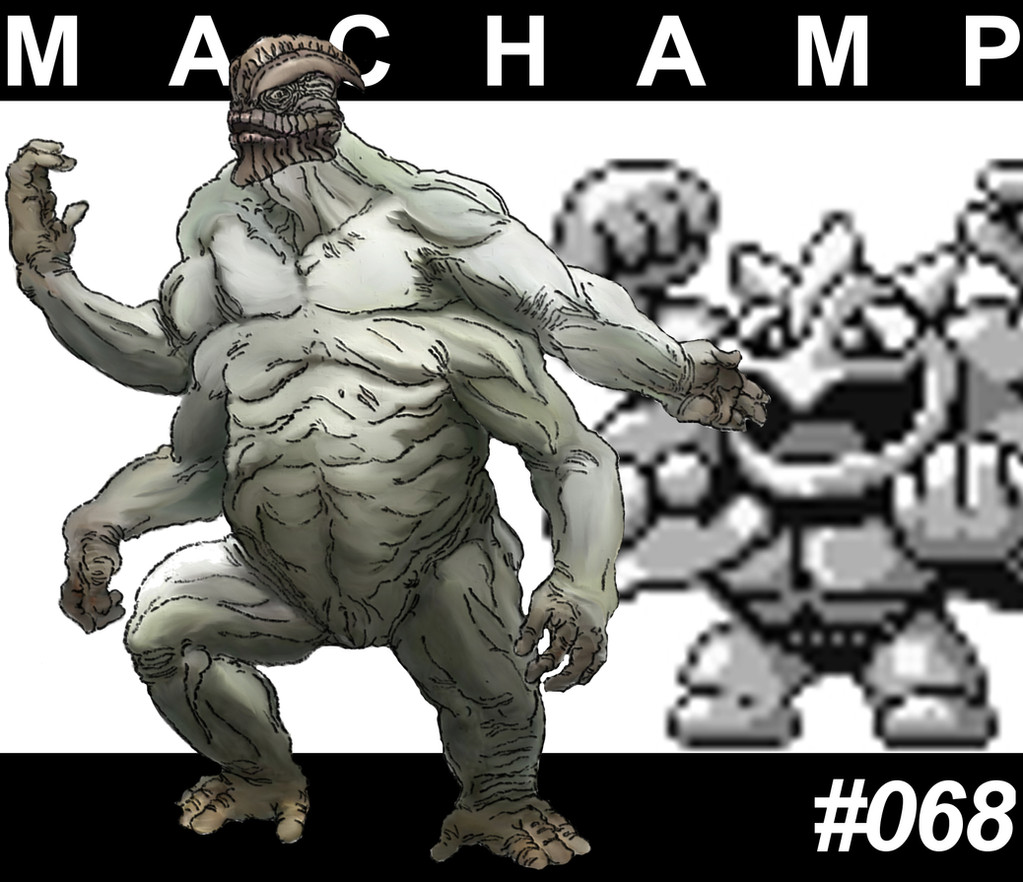HOME | DD
 womack90 — Machamp #068
womack90 — Machamp #068

Published: 2013-11-06 01:14:28 +0000 UTC; Views: 5564; Favourites: 59; Downloads: 0
Redirect to original
Description
IntroductionFirst recorded into the Pokedex by Western scientists in 1972, the Machamp is a comparatively large species of Fighting-type Pokemon only rarely found in the wild on the African continent. Possessed of incredible muscular strength and exceptionally durable flesh, Machamp are incredibly dangerous in physical confrontations. However, Machamp are noted for possessing relatively small brains for their size, resulting in decreased cognitive abilities and slower nerve impulses than one might expect; additionally, Machamp are capable of secreting vast amounts of adrenaline when provoked and even the female members of the species produce more testosterone than any human male. Taken together, these traits make the Machamp an aggressive and territorial Pokemon that is somewhat difficult to control in captivity, and the Pokemon League has ruled that all Trainers wishing to work with the Pokemon must possess a Class-A license.
Records of wild Machamp are scarce as the metamorphic line is sexually mature in the Machoke stage, and very few of the creatures survive long enough to metamorphose into a senior specimen. In addition, the range of the Machamp line has contracted significantly due to human activities, and the mature Pokemon is listed as vulnerable by the Pokemon League. As such, any social grouping of the metamorphic line is often dominated by a single large 'boar' Machamp, though there is documentation of matriarchal groups as well; moreover, as a result of their size and ferocity, these Pokemon often dominate the ecosystems that they exist within. It is noteworthy to mention that captive Machamp are considerably more common as a Machoke may be forced to undergo metamorphosis when exposed to the energy inherit in Transference.
Physiology and Biology
As noted previously, Machamp are truly massive creatures. Male specimens routinely weigh between 400-600 lbs, with females usually weighing around half as much as their male counterparts. Although sometimes seen walking biped-ally for short distances (during which time males usually measure around 7 ft), Machamp are much more comfortable locomoting via knuckle-walking, similar to the comparatively large Slaking.
Interestingly, unlike other omnivorous and carnivorous species, Machamp have wide-set eyes (a frequent trait of prey animals). This facial arrangement gives the Pokemon greater relative visual acuity, and protects the delicate ocular system from the punishing blows that the species often endure. Additionally, the flesh of a Machamp is dense, often measuring up to 1.5 cm, and is nearly impervious to laceration, contusion, or abrasion. The sheer physical durability of the creature means that the average specimen can be expected to live for over a century.
Behavior and Ecology
Like the other members of their metamorphic line, Machamp have a patchy distribution. The habitat of the species ranges from mountain peaks to lower montane forests between 2000 and 10,000 ft above sea level.
A Machamp's day is synchronized, divided between resting periods and travel/feeding periods. Machamp mostly eat insects, though they may also forage for leaves, stems, and fruit.
Reproduction and parenting
As mentioned previously, this metamorphic line reaches sexual maturity at the Machoke stage. Females mature at 12-19 years (though sexual maturity has been reached as early as 9 for captive specimens); males at 14-23 years.
Mating occurs between May and August when the females enter estrous. During this period, males often engage in combat over females and territory by grappling with one another upon their hind legs, with the loser eventually being pinned to the ground or thrown a considerable distance. The winner of such a conflict will then display for the female in order to gain information about her receptivity. Unfortunately for male Machamp, females are antagonistic and will resist the male during the early phases of courtship; therefore, the male must restrain the female during initial coitus to avoid being hurt. Copulation itself occurs when the male inserts his hemipene into the female's cloaca.
If fertilization was successful, the female will lay her eggs in burrows created in the sides of hills. Typically clutches are laid one month after fertilization, and have an incubation period of 9-10 months, with clutches containing an average of 3 eggs.
The hatching process is exhausting for the neonates, as this metamorphic line's eggs are leathery and predictably durable; the infant Machop will strain against its shell for several hours before finally managing to free itself using their head crest.
_______________________________________________________________________________________________________________________________________
Personal Note: Slowly, slowly, he learns to paint.
Done predominantly for my group The-Poke-Project.
























